
One of the most glamorous names in Automotive history is turning 100 this year.
Not many companies can claim this. Last year it was Aston Martin’s turn (see post here), this year it is Maserati.
Maserati has long lived in the shadows of two more famous Italian names in the sports car world, Ferrari and Lamborghini. This is a mistake though.
Maserati has a richer history than either Ferrari or Lamborghini. In the 1950s the most glamorous and expensive sports cars in the world were not Ferrari, but rather Maserati. Heads of state, Presidents and Royalty who wanted the best drove a Maserati. Shah of Persia, Aga Khan, King Saud of Saudi Arabia, Gunther Sachs and Briggs Cunningham. Lastly we must not forget: The greatest race driver of all time, Juan Manuel Fangio experienced most of his most important wins in Maserati racecars. Given this important birthday of one of the most fascinating brands, we are going to do a 5 part series on Maserati to celebrate their 100 years.
- The first part (this one) will concentrate on the history.
- The second part will be dedicated to the AG6CS-perhaps the most beautiful Maserati ever built.
- The third part will be on the model that saved Maserati from bankruptcy, the 3500 GT.
- The fourth part will be on the 5000 GT which was technically the first super car ever made by any car company.
- The fifth and last part we will look at another Icon, the Maserati Ghibli, before Maserati was taken over by Citroen
It all started with ‘the trident’
Ask someone what is the most important feature of Maserati and they will likely answer: The trident.
The trident, which is part of the famous logo of Maserati is a relative mystery. Few people are aware though who designed the logo or where it comes from. The logo comes from the Fountain of Neptune which is located in Bologna Italy. Neptune is carrying a ‘trident’ and it is this statue (see link) which was the inspiration for the Officine Alfieri Maserati Spa Logo, which is perhaps among the most recognized logos in the sports car world.
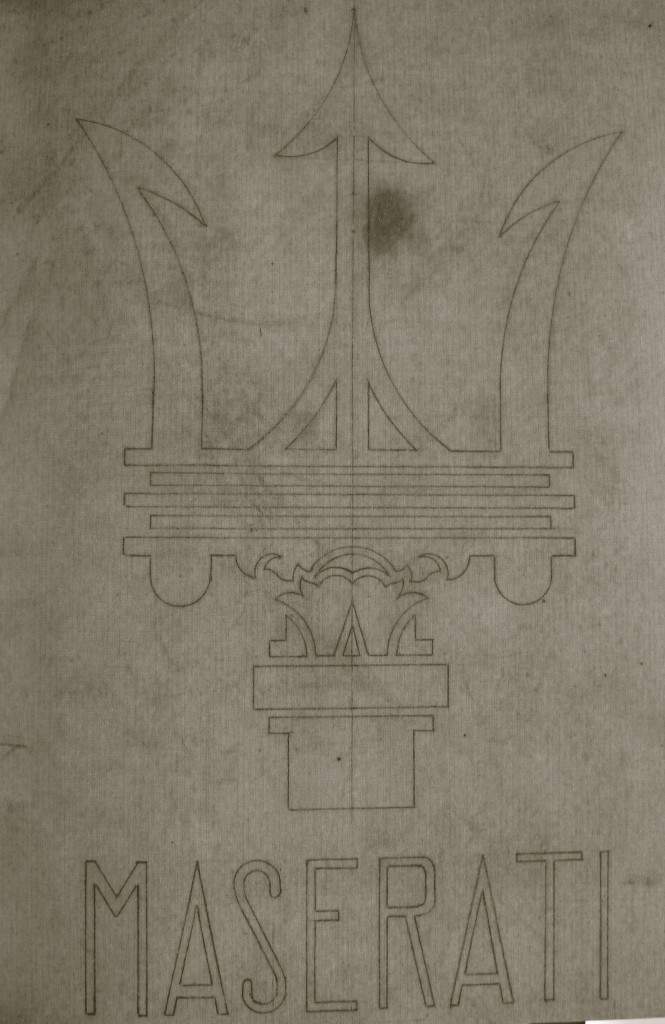
(Credit: Jürgen Lewandowski, ‘Maserati’ 2008 Motor Buch Verlag. An original sketch of the Maserati logo- one of the most famous logos in the world)
All in the family
The Maserati clan consisted of seven brothers.
Carlo, who was the eldest brother (born 1881) showed unusual talent for engineering at an early age, and by 17 was already designing single cylinder engines. Next stops for Carlo included work at FIAT, Isotta Frashini and Bianchi. Tragedy strikes the Maserati brothers when the gifted Carlo dies in 1910 and Alfieri takes over. In 1913 Alfieri takes over the Isotta Frashini service center. Already the next year in 1914 on the 1st of December the company ‘Officine Alfieri Maserati’ SA is registered in Bologna.
Timing does not seem to be on the Maserati brother’s side and in 1914 war breaks out. The Italian government uses the expertise of the Maserati brothers which they have built up and that enables them to survive. In 1926 Maserati introduces its first race car called the ‘Type 26′. The Type 26 would be the first racecar to carry the Maserati badge. While Maserati had won some important races with the type 26, bad luck was to strike again. In 1932 Alfieri, long the head of the clan, died of kidney failure (he had lost an kidney in the 1920s due to a racing accident). While the Maserati brothers by now had created a relative successful racing company, there was increasing pressure coming from the Germans with Auto union and Mercedes Benz. In 1937 the brothers took the difficult step and decided to sell the majority of the company to Adolfo Orsi who was a well known Italian industrialist with business interests in steel and farming equipment.
It was an end of an era for the Maserati brothers who would go on to found OSCA, another well -known carmaker.
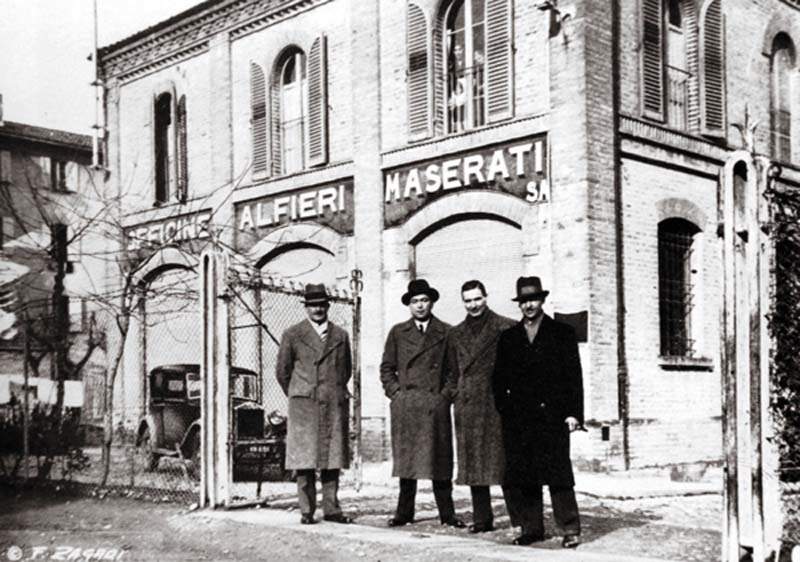
The Maserati brothers from left to right: Ettore, Bindo, Ernesto and Alfieri II.
While all Maserati Brothers certainly played a role in Maserati’s development is was Alfieri II (below- credit: Maserati archives/100yrs website dedication) who can be considered the ‘founder’ of Maserati until his tragic death in 1932. In dedication to the importance Alfieri played in Maserati’s history, this year at the Geneva Salon, Maserati has dedicated its newest sports car to be called the Alfieri, in honor of the ‘founder’ (see link here).

The Adolfo Orsi Period
Adolfo Orsi come to Maserati at the right time.
The racing division under pressure from the Germans, with Mercedes Benz, Adolfo Orsi took over full control of the company in1937. Orsi was a brilliant strategist, and his main priority was to get Maserati’s financial house in order and run the firm not like a family company, but rather like an industrial one. During the second world war, Maserati-in order to survive-went into spark plugs and batteries. It was not until 1946, that Maserati finally introduced its first road car- the A6. Shortly after Maserati’s first road car was born, the Maserati brothers decided to leave the company under Orsi. Maserati had become an industrial company and the Maserati brothers didn’t feel comfortable in this environment- so in 1947 they left and went on to found another car company, OSCA.
For Maserati however, the best was yet to come. In the beginning in the 1950s Maserati became the most successful racing car manufacture due to one man: Juan Manuel Fangio. In 1954 Maserati secured the Argentian Grand Prix with the 250 F under Fangio- and a legendary battle would soon start between two great Ialian brands: Ferrari & Maserati. At the same time, Orsi knew in order to survive he would have to secure Maserati’s success also for road cars. In order for this to happen Orsi restructured his business activities further getting rid of the sports division and only concentrating on automotive areas. He also brought his son Omar on board to help him.
The A6G 2000
What would help the road cars of Maserati the most however had nothing to do with road cars but with one man, Juan Manuel Fangio.
Having left for Ferrari, Fangio returns to Maserati and wins the F1 world championship title for the fifth time. What better credibility to give to their road cars than incorporating the technology from their racing cars (something Ferrari has perfected early on). Maserati started attracting the world’s attention with the A6G 2ooo series of cars which they built between 1947-1956. The ‘A’ stood for Alfieri, the Maserati brother who had passed away, the ’6′ because it was a straight six cylinder car, with a 2L engine (thus the 2ooo). These early Maserati sport cars were ordered by celebrities and heads of state. With famous coachbuilders lining up to build the cars, like Zagato, Frua and Allemano, the A6G 2000 Maserati are among the most collectible and beautiful cars today. Only 139 GT cars of the A6G 2000 were made.
Below an A6G Maserati bodied by Zagato. Today examples like the one below are worth $2.5- 3.0m.
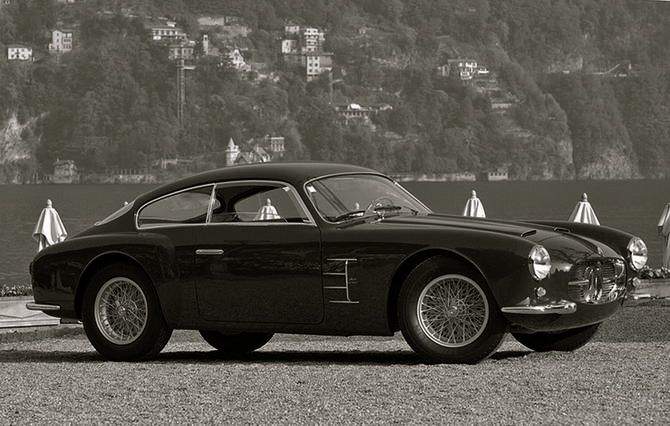
The real breakthrough, the 3500 GT Maserati
While Maserati was starting to make a serious name for themselves in road cars, the truth is that the owners, the Orsis- especially Omar, was more interested in the racecars than road cars.
This is why Maserati did not build out a good dealer network that would have been able to sell more cars. A man who would almost single handedly change Maserati’s fortunes, as far as road cars was concerned, was Giulio Alfieri. Not related to the ‘founder’ of Maserati who also was an Alfieri (see above) Giulio Alfieri was Maserati’s chief engineer. Taking the 300S race car as a starting basis he designed a 2+2 GT sports car called the 3500 GT. It was powered by six cylinders and three weber carburetors, good for 220hp and carried a 4- speed gearbox. The 3500 GT coupe was designed by Touring of Milan (the convertible’s were designed by Vignale). The 3500 GT was a tremendous success for Maserati and firmly established Maserati as a manufacturer of high- class sports cars and a serious competitor to Aston Martin, Ferrari and Mercedes Benz. Nearly 2000 cars were built between the seven-year production period (1957-1964).
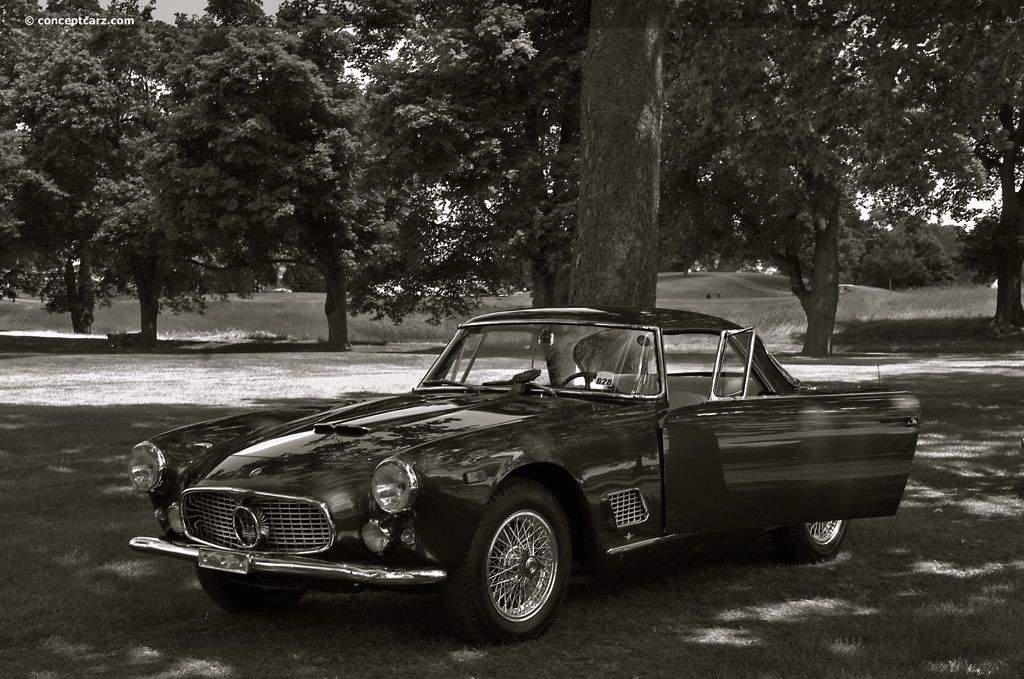
The shah of Persia and the 5000 GT
By the end of the 1950s Maserati road cars became desirable objects for those who could afford them.
One such person who had no problems buying the best sport cars in the world was, Mohammed Reza Pahlavi, also known as the Shah of Persia. On one of his visits to Europe he asked Maserati if they could make the 3500 GT more powerful, like for example the 450S which essentially was a racecar. Alfieri and Orsi did not want to disappoint the Shah and thus the model 5000 GT was born. The 5000 GT was really the world’s first super car (the Miura despite popular wisdom was not the world’s first super car). The engine capacity was massively enlarged to 5000cm3 from a previous 3500 and was now powered by a V8 engine, producing at least 340hp (more than 100hp found in the 3500 GT).
The first 5000 GT (bodied by touring) was delivered to the Shah in 1959 and only 23 models were ever made. The subsequent lucky owners of the 5000 GT read like the ‘A’ list of the worlds powerful, wealthy and royal at the time. Agnelli (head of Fiat), Cunningham, King Bin Saud (Saudi Arabia), Innocenti (of the Italian Industrial fortune), Aga Khan, Lopez- the President of Mexico. The 5000GT was so expensive that Maserati stopped building them after only 23 deliveries.
The 5000 GT was Maserati’s crowning jewel! More exclusive and more powerful than any Ferrari at the time, it was clearly a car for the elite who wanted something unique and hand built. Maserati would never build such an exclusive and expensive car again and many experts of Maserati history regard the 5000 GT as the high point for the company.
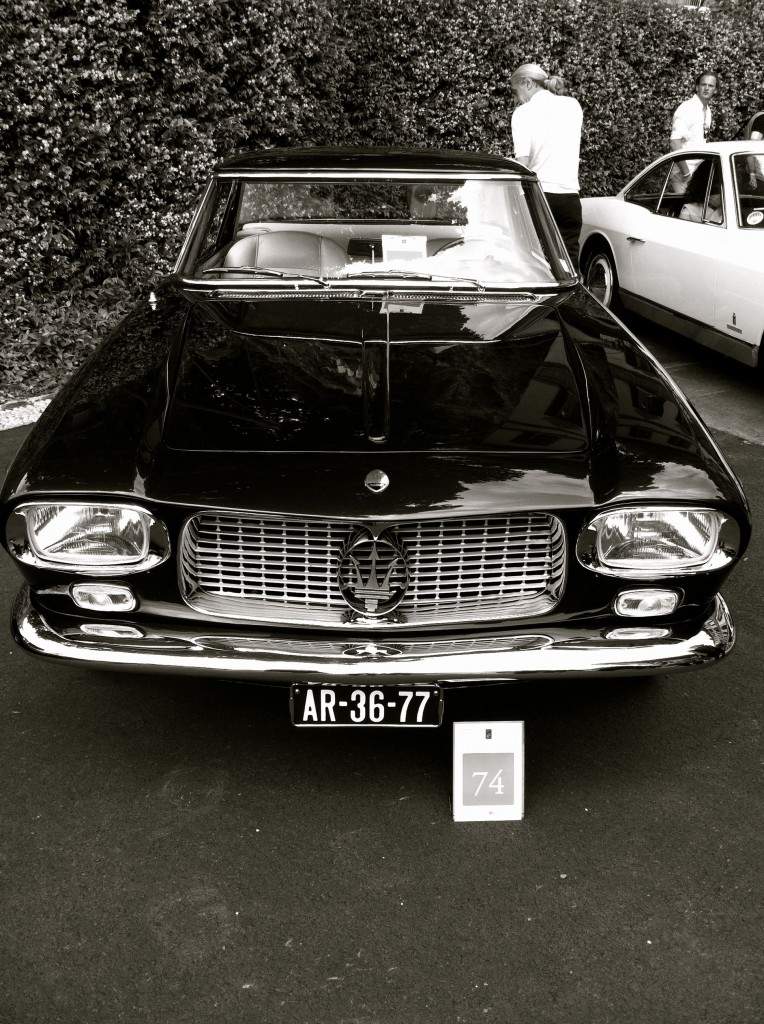
(Above: Fit for a king. The 5000 GT by Maserati shown at Villa D’este Concourso Eleganza in 2012)
The last great Maserati Supercar: The Maserati Ghibli
Maserati would continue the success of the V8 engined cars, first with the Quattroporte introduced in 1963 at the Turin fair but also with the Mexico which was a two door coupe introduced in 1966.
However it was Giugiaro that captured worldwide attention with the Maserati Ghibli in 1966. The Ghibli was a tremendous success for Maserati, and the design firm Ghia – who under Giugiaro designed the Ghibli can take major credit for creating a super car in the late 1960s and 1970s. The Ghibli outsold its two main rivals at the time, the Lamborghini Miura (only 764 made) and the Ferrari Daytona (1284 made). The Ghibli was a GT car (a coupe) powered by a V8 engine capable of 0-100km/h in only 6.8 seconds. The most sought after and collectible Ghibli is the convertible model SS version (SS meant the more powerful 4.9L version) and good examples today can command over $1m. Only 1150 coupes were made and 125 Convertibles built (of which 25 were SS versions).
Despite the success of the Maserati Ghibli, Maserati’s had too many different models on the market which each had their own platform (Mexico, Mistral, Quattroporte, Ghibli. At the same time some of the other businesses in Orsi’s conglomerate were not doing well, and so by 1967/1968 Orsi was looking for potential buyers for Maserati. They found Citroen, who would take over Maserati by 1968 with a 6o% equity stake.
It was an end of an era for the great Italian sports car manufacturer. While Maserati made some successful models under Citroen, like the Khamsin, Bora and Merak – clearly the exclusivity and glamour that once stood for this great name in Italian sports cars was gone.
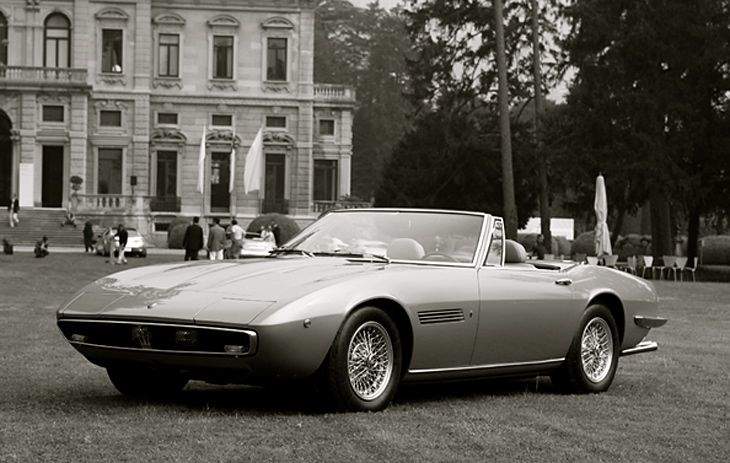
The beautiful Ghibli spider designed by Ghia designer Giugiaro. The version above is a highly collectible SS version. Credit – Simon Kidston
(Main picture above credit- Walter Bäumer, showing several A6G 2000 at the Maserati factory sometime in the 1950s.)Further reading- for those interested in further exploring the history of Maserati – we recommend the following books:
- Maserati Road Cars ‘The Postwar production cars 1946-1979′, by Crump & Box
- ‘Maserati’ by Jürgen Lewandowski, 2008 Motor Buch Verlag (in German)
- ‘Maserati A6G 2000 Zagato’ by Walter Bäumer
- Octane ’100 Years of Maserati’ Issue 128 02/2014
- Classic & Sportscar magazine, ‘Maserati at 100′, April 2014
